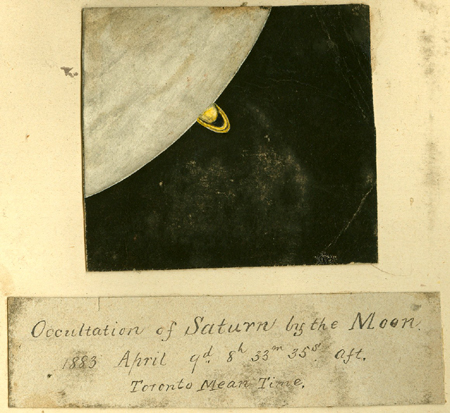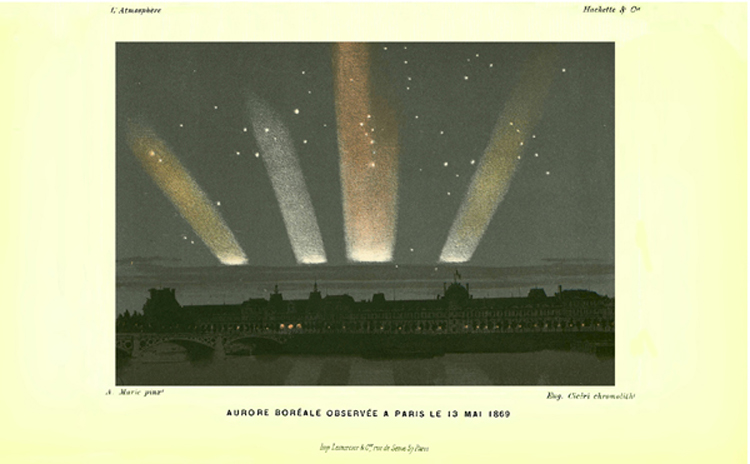
Mare Crisium as sketched by Eva M. Brook on December 3rd, 1895 at Simcoe, Ontario. 12-inch reflector (image © RASC Archives)

Occultation of Saturn by the Moon. 1883 April 9th 8h 33m 35s aft. Toronto Mean Time. Sketch by A.F. Miller (image © RASC Archives)

Aurora observed at Paris on 1869 May 13; Camille Flammarion, L'atmosphere description des grands phénomènes de la nature, 2nd ed. (Pairs: Librairie Hachette et Cie, 1873), between pp. 768 & 769 (image © RASC Archives)
Open a recent edition of the RASC's Observer's Calendar to any of the featured images, and you will experience the visual vocabulary of the modern astronomical sublime. We have been producing this publlication for twenty eight years, and the entire run of calendars displays spectacular "otherwordly" vistas limited only by the technologies available to amateurs of the time. The three images reproduced above, from the earliest periods of the Society's activity, also portray the astronomical sublime—"Spectacles of Nature"*—through artistic media avaiable in the late 1860s, and 1880s-1890s. Do they evoke the same responses in modern viewers as they did in the viewers who saw them for the first time? Probably not, or at least not without a powerful exercise of imagination on our part to peel back time (a process which itself argues for changed perceptions). A broader aspect of expereince unities us as observers to our Victorian predecessors; as observers we are informed spectators of thimgs interminably old and the starlingly new, at unimaginable distances, subject to and exerting forces beyond our command. Part of the attraction of astronomy lies in this response to nature first characterized as the "sublime" in the Augustan era (Longinus), and most meaningfully developed in the age of Newton and Herschel (e.g., 1757). The title of a recent book on Hubble Space Telescope imagery, Picturing the Cosmos: Hubble Space Telescope Images and the Astronomical Sublime (2012), shows that the "sublime" is still seen (and fought over) as a useful category to describe responses to astronomical phenomena. Some of the contours of recent discusisons can be accessed, not inappropriately, through Jayanne English's "Canvas and Cosmos: Visual Art Techniques Applied to Astronomy Data" (2017).
Unfortunately, there is as yet no good open-access historical survey of the astronomical sublime to which listeners can be directed.
The notional cat in the podcast has its counterpart in the sky. In the age when the theory of the sublime was developed, the redoubtable Jérôme Lalande (1732-1807), fond of felines, made the cat conceptually part of the spectacle of nature by creating the constellation felis.
The passage from NIcole Oresme (ca. 1320-1382), Bishop of Lisieux, extolling diversity over uniformity in the universe as the source of its grandeur, is taken from Nicole Oresme and the Kinematics of Ciruclar Motion: Tractatus de commensuabilitate vel incommensuabilitate motuum celi, ed. Edward Grant (Madison–Milwaukee–London: The University of Wisconsin Press, 1971), pp. 173-175, 311-313.
The Rev'd Thomas Burnet's (ca. 1635-1715) wish for for a better-designed universe with uniform stars uniformly arranged(!), occurs in his The Sacred Theory of the Earth: Containing an Account of the Original of the Earth, and of All the General Changes Which It hath Undergone..., vol. I, 4th ed. (London: John Hooke, 1719), pp. 438-439. Burnet, much admired by Isaac Newton, played a role in geological theorizing in the sceintific revolution. It has to be said that the fourteenth-century bishop's view of what makes the visual heavens beautiful (take the universe as it is) is closer to our views than those of the contemporary of Newton. History does that; "progress" is not a glorious linear curve, straight and ever upwards to the present.
Jeremiah Horrocks (1618-1641) was a gifted mathematical practitioner, as well as a spell-bindingly awful poet. The wonder is that a literary age which could produce a Henry Vaughan could also produce a Jeremiah Horrocks. The best translation of Horrocks' transit of Venus account, with poetry, is now Venus Seen on the Sun: The First Observation of a Transit of Venus by Jeremiah Horrocks, tr. Wilbur Applebaum, History of Science and Medicine Library, vol. 29, Medieval and Early Modern Science, vol. 18 (Leiden Boston: Brill, 2012). Only the less accurate 19th-century translation, however, is open access; The Trasnit of Venus Across the Sun...by the Rev.[sic.] Jeremiah Horrox..., tr. Arundell Blount Whatton (London: William MacIntosh, 1859).
Examples of astronomers inspired by astronomical phenomena
- Great Comet of 1744 (C/1743 X1): Charles Messier (1730-1817), & Jérôme Lalande (1732-1807); Jean Baptiste Joseph Delambre, Histoire de l'astronomie au dix-huitième siècle, ed. Claude Mathieu (Paris: Bachelier, 1827), pp. 547-548 (Lalande), 767-768 (Messier)
- total eclipse of the Sun of 1748 July 25; Charles Messier (1730-1817), Jérôme Lalande (1732-1807), and the Rev'd Dr. Nevil Maskelyne (1732-1811); Jean Baptiste Joseph Delambre, Histoire de l'astronomie au dix-huitième siècle, ed. Claude Mathieu (Paris: Bachelier, 1827), pp. 548 (Lalande), 623 (Maskelyne), & 768 (Messier)
Society members' experiences of the astronomical spectacles of Nature during the 1890s
-
1890 December 30 Saturn "its magnificent and graceful rings and attended by its Family of eight satellites, it presents in the field of view of a powerful telescope a gorgeous spectacle, one never to be forgotten"; Joseph Morrison, “The Disappearance of Saturn’s Rings", Transactions of the Astronomical and Physical Society of Toronto for the Year 1890-91 (1892), 23-28, at p. 23
-
1892 February 9, a visually striking conjunction of Jupiter and Venus resembling "a beautiful and most lustrous double-star...magnificent spectacle" is reported by Allan F. Miller, Andrew Elvins, Arthur Harvey, and Larratt W. Smith; Transactions of the Astronomical and Physical Society of Toronto for the Year 1892... (1893), 5
- 1892 July 26 Anderw Elvins reporst thqt "The most brilliant display of aurora which I have seen since 1872...the whole Northern heavens suddenly lighted up and, for a few minutes, presented a most gorgeous spectacle. It seemed as if the hitherto clear sky had become covered with patches of light cloud invisible except when, with a sort of electrical scintillation, they were, as if by sheet lightening, splendidly illumined by auroral light passing in rapidly succeeding rushes, or waves, or pulsations..."; "Auroral Displays", Transactions of the Astronomical and Physical Society of Toronto for the Year 1892... (1893), 53-56, at p. 54
-
1895 March 19 lunar eclipse, reported by Arthur Harvey as "A more wonderfully beautiful sight could not be imagined. The upper edge of the Moon was of a beautiful blue, below and on each side was the loveliest tint of rose, then followed a yellow, a copper colour, the darkest parts of which were bronze. Though several eclipses recur to memory, none so beautiful is among them. The colours of the sunset were in a manner reproduced"; "The Lunar Eclipse, March 10", Transactions of the Astronomical and Physical Society of Toronto for the Year 1895... (1896), 20-23, at pp. 20-21
-
1832 Great Leonid Storm with its peak zenith hourly rate (zhr) of 60,000 meteors, remmbered on 1897 March 30 by Henry Meredith, who reported that viewers were "amazed and awe struck by the extraordinary spectacle which the heavens presented. It was as if all the stars had become suddenly unfixed and were rushing pell mell to the Earth, leaving the firmament an empty void. It looked indeed like a shower of fiery snow flakes, so thickly and yet so gently did the falling stars seem to come down"; E.A. Meredith, "The November Meteors of 1832 and 1833", Transactions of the Astronomical and Physical Society of Toronto for the Year 1897... (1898), 10-19, at p. 11
*The conception of nature on display is even reflected in one of the all-time best sellers in science popularization of the Enlightenment, the abbé Noël-Antoine Pluche's (1688-1761) Le spectacle de la nature, ou entretiens sur les particularitiés de l'histoire naturelle...troisieme partie, contenant ce qui regarde le Ciel... (Paris: Knapen & Fils, 1787)—this is the astronomical part of that multi-volume work. On Pluche, see Écrire la nature au XVIIIe siècle: autour de l'abbé Pluche, ed. Françoise Gevrey, Julie Boch, and Jean-Louis Haquette, Lettres françaises, série XVIIIe (Paris: Presses de l'Université de Paris-Sorbonne, 2006). HIs works were also rendered into English in the eighteenth century.
—R.A. Rosenfeld
A transcript of this podcast is available.
